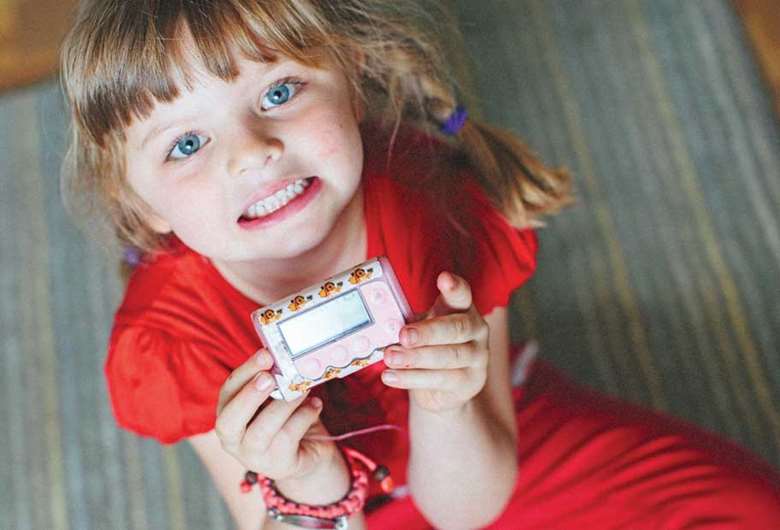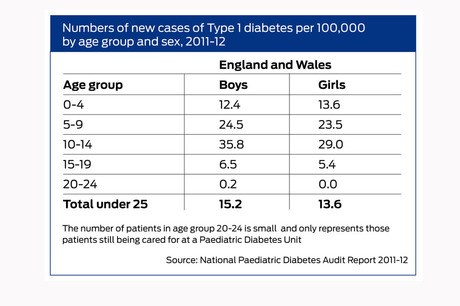Type 1 diabetes on the rise among the under-fives
Monday, July 14, 2014
While the rise in the number of adults being diagnosed with Type 2 diabetes hit the headlines again recently, what is less reported is the sharp rise in recent years of the number of under-fives diagnosed with Type 1 diabetes.

Type 1 diabetes is a life-long condition and can be life-threatening if not spotted early enough.
Unlike Type 2 diabetes, which largely affects adults, 35,000 children and young people under 19 have a diagnosis of Type 1 diabetes; about 700 have Type 2. Ninety-five per cent of children with diabetes in the UK have Type 1.
Experts are alarmed by the rise in Type 1 diabetes in young children, particularly as its cause is unknown.
Research published in The Lancet in 2009 suggested that cases of Type 1 in children under five across Europe may double by 2020. The annual increase in children aged four and under was 5.4 per cent over the period 1989-2003.
Justin Warner, a consultant in paediatric endocrinology and diabetes at the Children's Hospital for Wales, Cardiff, and clinical lead for the National Paediatric Diabetes Audit for England and Wales, said there seems to have been a rise in the past two or three years in the diagnosis of Type 1, and particularly among under-fives.
The annual audit - the next report is due in September - covers the outcome measures and care processes for children with diabetes.
The most recent UK figures show that the incidence rate per 100,000 of Type 1 in children is rising - that is the number of newly diagnosed cases of diabetes in a specific age group over a specific time period per total number of children and young people in the general population.
Among children aged four and under it rose from 11.5 in boys and 11.2 in girls per 100,000 in 2010-11 to 12.4 in boys and 13.6 in girls per 100,000 in 2011-12. Dr Warner said, 'No one knows why, because no-one knows the trigger. It's an autoimmune condition and some people have a propensity.'

He said it could be triggered by a viral infection, 'but that is unproven', and that it was important to stress that lifestyle factors are not associated with Type 1 diabetes.
'It's a no-blame condition. It's not due to obesity. It's an autoimmune condition, which means that some people are pre-disposed to develop it, but something has to trigger it.'
While 'there is a genetic risk component, where several generations may develop it', this is very small.
However, although the cause of Type 1 diabetes is unknown, the environment is thought to be a key factor.
'The fact that it's increasing is a difficult one to explain. There must be some environmental influence, because you wouldn't get such an increase over time if it was purely genetic,' Dr Warner said.
There is a higher incidence of Type 1 in northern Europe than elsewhere, although there are anomalies - rates are high in Sardinia, for example.
Unlike the United States, there has not been 'an explosion' of Type 2 diabetes in children and young people, 'although obesity is still a problem', he said.
Libby Dowling, clinical adviser for Diabetes UK and a paediatric nurse specialist, said, 'We are seeing a rise in Type 1 in children, and in under-fives particularly. It's the age group that we have seen the biggest rise in recent years. Type 1 is nothing to do with lifestyle or being overweight and the rise is too steep to be linked to genetics.
'It could be something that children are being exposed to, or not being exposed to, is triggering it or that there is something that used to protect them which they are not exposed to any more.'
She said that there was a 'very slight genetic link': if your father has Type 1 you have an 8-9 per cent chance of developing it, and if it is your mother this is 2-3 per cent.
A survey carried out by Diabetes UK in 2012 found that nine out of ten parents were unaware of the four main symptoms of Type 1 diabetes.
To address this, the charity launched a campaign to highlight the '4Ts' of Type 1 diabetes symptoms for parents and carers: toilet, thirsty, tiredness and thinner.
Any child displaying these four symptoms should be tested straight away as they risk becoming seriously ill very quickly.
The campaign was also targeted at GPs, practice nurses and those working in accident and emergency, as there are cases of parents being initially told their child has a urine infection or a virus.
A quarter of children with Type 1 diabetes are only diagnosed once they are already very ill with diabetic ketoacidosis (DKA), a life-threatening condition.
Ms Dowling said that in very young children the signs could include bedwetting, heavier nappies, children asking for the toilet more, an unquenchable thirst - she has heard of cases of children drinking from the bath - unnaturally tired, just wanting to go to sleep and not play, and becoming thinner.
Symptoms tend to develop over a few weeks, but if diagnosis is missed children can get very unwell very fast.
Other classic signs are thrush, abdominal pain and constipation, but at two and three these may not be so obvious.
'If you miss these early signs children get increasingly unwell, vomiting and losing consciousness,' she said. 'If you suspect diabetes get to your GP and insist on a blood test there and then.'
If children are diagnosed with Type 1 diabetes they will need treatment for life. Treatment involves insulin injections five or six times a day using a 'pen' injector to inject insulin under the skin, not into a muscle or a vein.
Alternatively, insulin pumps are becoming increasingly popular with young children.
The pump is about the size of a small mobile phone and delivers a flow of insulin during the day or night.
The pump reservoir usually holds a few days' supply of insulin, and the dose is adjusted depending on the carbohydrate content of meals and snacks.
A bolus (a dose of fast-acting insulin) can also be given if blood glucose levels rise too high.
For pre-school children the parent and the child's paediatric diabetes nurse specialist would usually train the early years staff and put together an individual health care plan, so that the staff know how to use the pump and adjust the units of insulin according to the amount of carbohydrate consumed.
- For more information, visit www.diabetes.org.uk/schools
 CASE STUDY: DAISY
CASE STUDY: DAISY
Helen Nurse, mum to five-year-old Daisy
'Daisy was diagnosed when she was 16 months. We took her to the GP on a Monday who booked her in for a blood test on Wednesday. But we were so worried we took her to A&E on Tuesday morning. Her blood sugar was so high she had developed DKA.
'Daisy was already with a childminder who she had a great relationship with and she came on the journey with us, and then at two-and-a-half Daisy went to a pre-school. It's such a complex disease. Caring for a child with Type 1 needs a lot of commitment to understand what you're dealing with, about the importance of balancing blood sugar, so that it's not too low or too high, so that Daisy can enjoy the day and thrive.
'We were very lucky. Parents need to feel confident enough to talk to the setting about their child. Diabetes is a very intensive disease and you need to have good communication.
One of the problems with very young children is that if they are sleepy or unco-operative or tantruming it could be to do with their blood sugar. The better the staff know the child the easier it is to spot the signs. I feel very close to the people looking after her.'
Claire Ocego, Statham Little Foxes Pre-School, Lymm, Cheshire
Claire worked as Daisy's special educational needs co-ordinator
'Type 1 is a very complex need. Helen took me on a training course to use the pump. I had to test Daisy's blood sugar level at snack times and at lunchtime and see how many carbohydrates she was having and then adjust the pump to administer the amount of insulin she needed. A sensor attached to the pump would give a warning signal if her blood sugar was too high or too low.
'All the staff were aware of the signs and symptoms regarding the highs and lows. Every day was different - if she had a cold or she was exercising it would affect her blood sugar.
'Daisy was included in everything. We have a persona doll, which we used to explain to the children how we would be working with Daisy and what would happen if she didn't have her medicine. We're a charity-run pre-school and it was hard to get extra funding as Daisy needed one-to-one care. It's important to have a good care plan in place and good communication with parents. Daisy is a fantastic little girl and very laid back. It's just part of her life.'




